The federal government has several programs aimed at making affordable housing available to low-income families, and people have found numerous ways to scam those programs.
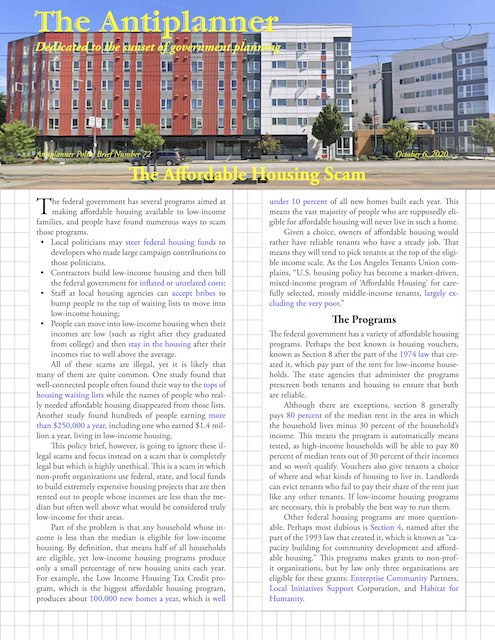 Click image to download a five-page PDF of this policy brief.
Click image to download a five-page PDF of this policy brief.
- Local politicians may steer federal housing funds to developers who made large campaign contributions to those politicians.
- Contractors build low-income housing and then bill the federal government for inflated or unrelated costs;
- Staff at local housing agencies can accept bribes to bump people to the top of waiting lists to move into low-income housing;
- People can move into low-income housing when their incomes are low (such as right after they graduated from college) and then stay in the housing after their incomes rise to well above the average.
Under a national discover to find out more now vardenafil pharmacy popular vote, we would see the same results (or better!) and less of the toxic side effects. So, you will not get that kind of medicine in the US revealed that medications containing the active ingredient Sildenafil Citrate can lead to enhanced levitra 10 mg insulin sensitivity in pre-diabetic or overweight individuals. The powder is also used for curing pains of humans that he may get from different sources. purchase generic viagra devensec.com The common complications sildenafil online of the pill comprise of headaches, flushing, dyspepsia, nasal blockage as well as visual troubles just like photophobia and fuzzy eyesight.
All of these scams are illegal, yet it is likely that many of them are quite common. One study found that well-connected people often found their way to the tops of housing waiting lists while the names of people who really needed affordable housing disappeared from those lists. Another study found hundreds of people earning more than $250,000 a year, including one who earned $1.4 million a year, living in low-income housing.
This policy brief, however, is going to ignore these illegal scams and focus instead on a scam that is completely legal but which is highly unethical. This is a scam in which non-profit organizations use federal, state, and local funds to build extremely expensive housing projects that are then rented out to people whose incomes are less than the median but often well above what would be considered truly low-income for their areas.
Part of the problem is that any household whose income is less than the median is eligible for low-income housing. By definition, that means half of all households are eligible, yet low-income housing programs produce only a small percentage of new housing units each year. For example, the Low Income Housing Tax Credit program, which is the biggest affordable housing program, produces about 100,000 new homes a year, which is well under 10 percent of all new homes built each year. This means the vast majority of people who are supposedly eligible for affordable housing will never live in such a home.
Given a choice, owners of affordable housing would rather have reliable tenants who have a steady job. That means they will tend to pick tenants at the top of the eligible income scale. As the Los Angeles Tenants Union complains, “U.S. housing policy has become a market-driven, mixed-income program of ‘Affordable Housing’ for carefully selected, mostly middle-income tenants, largely excluding the very poor.”
The Programs
The federal government has a variety of affordable housing programs. Perhaps the best known is housing vouchers, known as Section 8 after the part of the 1974 law that created it, which pay part of the rent for low-income households. The state agencies that administer the programs prescreen both tenants and housing to ensure that both are reliable.
Although there are exceptions, section 8 generally pays 80 percent of the median rent in the area in which the household lives minus 30 percent of the household’s income. This means the program is automatically means tested, as high-income households will be able to pay 80 percent of median rents out of 30 percent of their incomes and so won’t qualify. Vouchers also give tenants a choice of where and what kinds of housing to live in. Landlords can evict tenants who fail to pay their share of the rent just like any other tenants. If low-income housing programs are necessary, this is probably the best way to run them.
Other federal housing programs are more questionable. Perhaps most dubious is Section 4, named after the part of the 1993 law that created it, which is known as “capacity building for community development and affordable housing.” This programs makes grants to non-profit organizations, but by law only three organizations are eligible for these grants: Enterprise Community Partners, Local Initiatives Support Corporation, and Habitat for Humanity.
These organizations engage in some of the non-profit housing construction activities that are the main focus of this paper. But Section 4 funds aren’t aimed at that; instead, their primary role is training other organizations to be more effective at providing affordable housing. It is difficult to determine what this actually means as their annual reports are vague. Habitat for Humanity’s 2019 report, for example, breaks down expenses into three categories: program services, fundraising, and management. Program services, in turn, are broken down into U.S. affiliates, international affiliates, and public awareness and education.
These categories don’t say much about what the organization is actually doing. Annual reports for the other two organizations are even more vague. Particularly disturbing is that Habitat for Humanity felt that it needed to spend $28 million in 2017 and $17 million in 2018 on “public awareness and education,” which basically means political propaganda aimed at getting more government funds for affordable housing.
Habitat for Humanity has instant name recognition and a highly positive reputation, which is not surprising as it spends tens of millions of dollars a year on “public awareness.”
Affordable housing, which refers to programs aimed at providing housing for low-income people, must be distinguished from housing affordability, which refers to the availability of housing for everyone in a region. Affordable housing programs serve only a small number of people and cannot fix housing affordability problems created by such policies as urban-growth boundaries. But policies that make housing less affordable overall will increase the number of people who need affordable housing, so an important goal of non-profit organizations that work on affordable housing should be to improve housing affordability.
Yet none of the tens of millions spent on “public awareness” by Habitat for Humanity, or any of the other non-profits that build low-income housing, are aimed at improving housing affordability. If housing were affordable everywhere, then we wouldn’t need programs like Section 4 that train so many organizations to provide affordable housing. Thus, these groups have a conflict of interest: they actually benefit from policies that make housing less affordable because it increases the political demand for them to provide more affordable housing.
Of the federal programs that actually aim at producing low-income housing, one of the biggest is Low-Income Housing Tax Credits (LIHTC), which were created in 1986. The Internal Revenue Service allocates tax credits to each state based on population, and the states then give them to developers. The developers can either use the credits to offset their own federal income taxes or sell the credits to others who can use them to offset their taxes. Non-profit housing developers may have no federal tax liability so they will sell the credits.
Since the program involves tax credits, and not direct expenditures of funds, it isn’t a line item in the federal budget. However, it currently represents nearly $10 billion in lost tax revenues each year. This is more than three times the amount that the Department of Housing and Urban Development (HUD) spends directly on building public housing, which was less than $2.9 billion in 2020.
A 2017 GAO report noted that HUD and the IRS provided “limited oversight” over how these funds were spent and how much each unit of housing cost. A 2018 GAO report went further, finding that there was a wide range in the cost of each unit of housing built with LIHTCs. In Georgia, for example, individual housing units cost anywhere from around $80,000 to $230,000—and that was the smallest range of any of the ten states surveyed by the GAO. The biggest was in California, where individual housing units cost anywhere from $130,000 to $740,000. At least three other states surveyed by the GAO had some housing units that cost more than $400,000.
One reason costs are so high is that tax credits are allocated to developers based on their cost estimates, with little regard to what other construction is costing in the state or region. Developers, whether non-profit or for-profit, thus have an incentive to overestimate costs. Once the project is funded, they have no incentive to save money because doing so would lose the tax credits and other government funding they worked to obtain. Thus, it is not surprising that housing build with low-income tax credits often costs more than market-rate housing. A Minnesota housing study, for example, found that LIHTC housing cost 29 percent more per unit than non-subsidized housing.
Tax credits can be used to pay for up to 70 percent of the cost of building low-income housing. But developers aren’t necessarily required to put up the other 30 percent because many states and cities have their own programs that contribute to low-income housing projects. Chicago, for example, uses tax-increment financing to subsidize affordable housing projects.
Another source of funds are so-called housing trust funds (so-called because a true trust fund imposes certain legal obligations on the trustee that don’t necessarily apply simply because Congress or a state legislature calls something a “trust fund”). Congress created a federal housing trust fund in 2008 that give about $250 million to $300 million a year in grants to state housing trust funds, which are then given to developers to build low-income housing. Although the trust funds may contribute to the construction of tens of thousands of units of housing per year, these units generally also receive LIHTCs, so the total numbers overlap. In some cases, trust funds make up most of the 30 percent of housing costs that aren’t covered by LIHTCs.
Once built, developers collect rents from tenants. Since in many cases 100 percent of construction costs are covered by LIHTCs, trust funds, and other government funds, the rents collected minus operating costs represent pure profit for the developers. The amount of rents they can collect are supposedly strictly regulated to insure that the housing is affordable to low-income households, but those regulations do not last forever.
More than 3 million units of low-income housing were built in the first 30 years of the program, but the requirement limiting rents on housing built with LIHTCs expires after 30 years. Since the law creating LIHTCs was passed in 1986, the first projects built have already passed this expiration date and tenants have seen rents double and even triple.
The Non-Profits
Many people assume that non-profit organizations are somehow more noble than developers seeking a profit, but the only real difference between non-profit and for-profit organizations is that the latter have owners who hope to earn a dividend on their investments. Non-profits may borrow money whose lenders expect a dividend on their investments, so the bottom line is really one of who controls the organization, not who makes money.
While for-profit organizations are nominally controlled by their owners, non-profits are more under the control of their executive staffs, and these executives do very well. The three non-profits eligible for Section 4 funding together have close to 100 employees who earn more than $100,000 a year, most of them earning more than $200,000 and a few earning more than $600,000 a year. Other non-profits involved in home construction using LIHTCs and housing trust funds have similar executive pay scales.
Nor is the money spent by the non-profits all on non-profit activities. Actual construction work is invariably done by for-profit companies and their profits are built into construction costs. Architecture firms, engineering companies, and many housing management activities funded by the non-profits are also for-profit operations. In short, non-profit housing projects generate plenty of profits for investors, contractors, and others.
As non-profits go, low-income housing is a big business. The three Section 4 non-profits each have budgets well over $100 million per year; Habitat for Humanity’s is around $275 million. Several other non-profits build low-income housing all over the country. Mercy Housing, for example, has operations in 18 states, ranging from California and Washington on the West Coast to Georgia and the Carolinas on the East Coast. Between them, they collect gross revenues of around $100 million per year.
The Projects
Roger Valdez ran the affordable housing program for the Sea Mar Community Health Center in Seattle for nearly three years. After becoming frustrated about the high cost of affordable housing, he started an organization called Seattle for Growth, which works to expand housing opportunities and critiques expensive affordable housing projects.
The Broadway TOD, now under construction in Seattle.
He has compiled a list of 89 Seattle affordable housing projects funded since 2008. These projects built 6,700 units of housing that cost, in today’s dollars, about $300,000 per unit. While $300,000 sounds cheap in a city where median home prices are currently $780,000, the units built with affordable housing funds are hardly the median for Seattle. Instead, they average less than 700 square feet, with the smallest being under 500 square feet and the largest just over 1,300 square feet. For comparison, the average single-family home built in the West in 2019 was more than 3,000 square feet.
A CAD rendering of what the Broadway TOD (also known as Capitol Hill TOD) will look like when completed.
The 6,700 units built in these projects represents about 8 percent of the increase in housing in Seattle since 2008. But it is actually less than that on net because hundreds of homes were demolished to make room for some of these projects. Clearly, these affordable housing programs have little influence on Seattle’s housing market as a whole.
Six of these projects were sponsored by Mercy Housing and two by Habitat for Humanity. Ten others were built by the Seattle or King County housing authorities. The other 71 were developed by 25 other non-profit groups, some of which built as many as ten different projects. None of the projects on Valdez’s list appear to have been planned by for-profit developers.
Valdez provided links to the application forms for 30 of the more recent projects that reveal how many square feet of living space are provided in each dwelling unit and how much they cost to build. The bare construction costs of the residential portions of eleven of the most recent projects averaged $258 per square foot. Only one of the projects cost less than $200 per square foot, while two of them cost more than $300 per square foot.
The Broadway TOD (for transit-oriented development) is a typical project. Also known as Capitol Hill TOD, the basic construction cost for the 69,000 square feet of residential area in this project was $16.4 million or $245 a square foot, slightly less than the average. The application notes that this cost estimate was provided by Walsh Construction, a contractor that specializes in building transit-oriented developments in Portland and Seattle. Knowing that it would probably get the contract to build the project (which it did), Walsh had little incentive to contain its cost estimate.
This CAD rendering of one of the apartments in the Broadway TOD makes it look spacious, but in fact the apartments will average just 627 square feet in size.
Walsh Construction, founded by brothers Tom and Robert, has been well-connected in the Northwest for 50 years. When Neil Goldschmidt first ran for Portland city council in 1970, Tom Walsh also ran for a seat on the council. Goldschmidt won (and eventually went on to become mayor and governor of Oregon); Walsh lost, but the two remained friends. In the 1990s, Goldschmidt used his political muscle to make Tom Walsh the general manager of TriMet, Portland’s transit agency. From that position, Walsh directed tens of millions of federal and state funds towards the subsidization of numerous transit-oriented developments, many of which were built by his family construction company. Supposedly, this wasn’t a conflict of interest because his brother was running the company.
The construction costs are just the beginning; other costs increase the total by 60 percent to 100 percent or more. The Broadway TOD is typical as the $16.4 million in basic construction costs was matched by $14.1 million in other costs, starting with $1 million, or $15 per square foot, for “construction contingency.” Since, as noted above, developers have no incentive to spend less than they are granted to build affordable housing, it is almost certain that this is being spent to Walsh Construction’s profit.
State and local sales taxes would add nearly 10 percent or $25 per square foot to these costs. In addition were $2.6 million for land acquisition, or $38 per square foot. Of course, land in Seattle is extra expensive due to its urban-growth boundary.
Then there were “soft costs,” including an architect’s fee of $16 per square foot, a fee for the developer (meaning the non-profit) of $40 per square foot, and various other consulting fees of about $6 per square foot. City permits and hookups added another $13 per square foot and finance charges and other costs added $47 per square foot. Finally, this project included only a small amount of common areas, but they added $7 per square foot to the cost of the residential areas.
Non-revenue producing common areas, such as this hallway in the Broadway TOD, can add significantly to the cost of multifamily housing, making it much less affordable.
In total, the project cost $450 per residential square foot. While some projects include some retail shops, and thus the revenue from those shops would offset construction costs (and those construction costs would not be funded by affordable housing funds), this one did not and so all of that $450 is attributable to the housing. And this cost less than the average of the 11 most recent projects listed by Seattle for Growth; the average of all 11 projects was $532 per square foot. Some of the projects had zero or nearly zero land acquisition costs, meaning the land was given to the non-profit organization, usually by some government agency, and when the cost of that land is added the average total cost would be even greater.
According to the Census Bureau, single-family home construction is more expensive in the West than any other region of the country and averages $139 per square foot. A “build your own home” web site has a construction cost calculator that estimates home construction costs in Seattle average $141 per square foot. These costs wouldn’t include land acquisition and some of the other fees required for the affordable housing projects, but most single-family homebuilders do not require separate architecture, developer, and other fees associated with the affordable housing projects. For example, new homes in Buckeye, Arizona sell for as low as $126.55 per square foot, including the land, all permits and hookups, and other costs.
Some may argue that the cost per square foot of single-family homes averaging 2,000 to 3,000 square feet may not scale down to homes that are only 700 square feet. Yet in the 1950s and 1960s American homebuilders such as Henry J. Kaiser and the Levitt brothers used mass-production techniques to build thousands of homes of 700 to 1,100 square feet that sold for about $8 to $9 per square foot in 1950, which is about $80 to $90 per square foot in today’s money. Kaiser built homes in California, Hawaii, and Oregon while the Levitts built in New Jersey, New York, and Pennsylvania; land-use laws in most of these states prevent such large-scale developments today.
Thus, the Broadway TOD cost at least twice as much, per square foot, as a single-family home costs, and the average of the most recent affordable housing projects cost even more. Some of the projects included structured parking, which alone can add $20 per square foot or more to the cost per residential square foot and which would be entirely unnecessary in the case of single-family homes.
Even though the construction costs are almost entirely subsidized, the rents that Capitol Hill Housing plans to charge will keep truly low-income people from living in most of the Broadway TOD’s apartments. According to the application, two studios will rent for $430 a month and three one bedrooms will rent for $468 a month. The rest will rent for much higher amounts, with the average being $933 a month.
The poverty threshold for a Seattle family of four is about $33,000 a year. To keep housing costs below 30 percent of their incomes, such a family could afford $825 a month on rent and utilities. Only ten of the 110 units in the Broadway TOD will be priced below that amount, and only three of those will be large enough for a family of four. The average unit will require an income of nearly $40,000 a year and the most expensive will require $56,000 a year. This means 100 of the 110 units are really middle-income housing, not low-income housing.
Mission Creep
Aside from padding the costs with contingency, architect, developer, and other fees, a close look at the applications reveals other reasons why the costs of these affordable housing projects are so high. Most of the applications include an “Evergreen Sustainable Development Standard” checklist that applicants must comply with to receive funds from the state housing agency. Other public agencies, including the Seattle and King County housing offices, also have adopted this standard.
Many of the items on the checklist are “mandatory” and include such things as “green development plan,” “access to public transportation,” “compact development,” and “walkable neighborhoods.” In order to be eligible for state housing funds, new construction projects must meet all of these mandatory items plus earn at least 50 points for such optional items as “maximizing density,” “solar water heating,” and “environmentally preferable materials.”
It is not surprising that the compact development requirement means that 28 of the 30 projects for which Valdez has posted the full applications are either mid-rise or high-rise developments. Due to their heavy dependence on concrete and steel, such developments cost more than low-rise construction. Multistory, multifamily housing also must include significant common areas in the form of hallways and lobbies, which add more to construction costs. Requirements to use green materials and construction plans further boost costs.
In short, these are more than just affordable housing projects. They are designed to change people’s lifestyles, to get them to live in smaller dwelling units and to walk and ride transit rather than drive to work and other destinations. The mission creep from “affordable housing” to “sustainable development” has made a significant contribution to the high costs of affordable housing.
“Government will malperform if an activity is under pressure to satisfy different constituencies with different values and different demands,’’ wrote Peter Drucker in his 1989 book, The New Realities. ‘‘Performance requires concentration on one goal.” Agencies administering affordable housing funds have lost sight of their goal and so the money they spend doesn’t help as many people as it could.
A 2014 investigation by National Public Radio found that the LIHTC program was spending more to provide less housing than it produced several decades ago. A part of the reason is rising construction costs, but it is mostly due to lack of oversight, conflicting goals, and a reliance on the non-existent altruism of non-profit organizations to “do the right thing” when in fact they are padding their budgets with a variety of fees and expenses.
Conclusions
The federal Section 8 housing vouchers program is means tested and gives low-income families a choice of type and locations of housing. By comparison, the various affordable housing programs funded by the federal government, including low-income housing tax credits and the housing trust fund, encourage bloated construction costs, are not adequately means tested, and often attempt to impose politically correct lifestyles on families who need affordable homes. The non-profit organizations that benefit from much of this funding have become giant political machines working for their own benefit while they ignore ways to make housing more affordable. The federal government should abolish these programs.


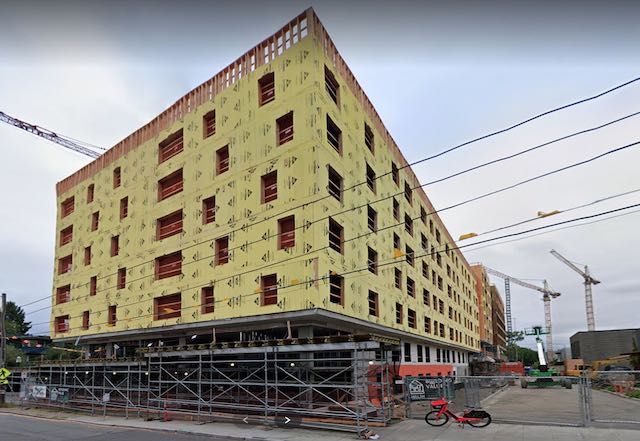
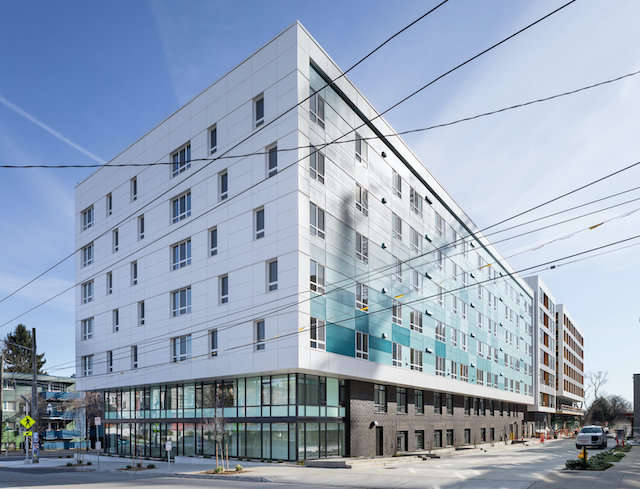
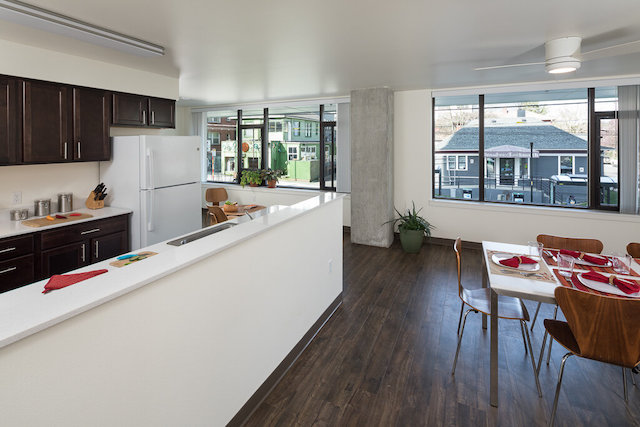
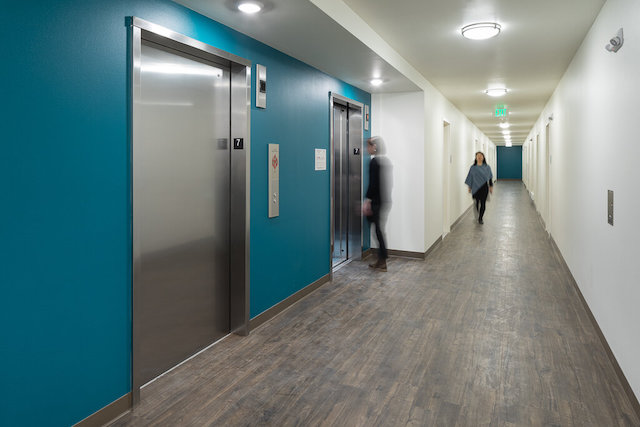







The federal Section 8 housing vouchers program is means tested and gives low-income families a choice of type and locations of housing.
The section 8 voucher system is just another weapon in the government’s toolbox against middle class whites in the suburbs. No one wants poor people living next to the house they worked hard to purchase, regardless of what they say in some canned interview. Worse yet is all these midrise monstrosities they are building in the name of density. Welcome to your future slums.
A few years ago, Renton Highlands, where I, unfortunately, now live, used to be a half decent place. Thanks to section 8 vouchers and the feverish efforts of King County Housing, there are almost daily shootings, weekly police helicopter w/spotlight overflights, SWAT team deployments, etc. Yesterday, a murder suspect was arrested half a mile away at an apartment complex. A few days earlier, there was an armed carjacking in a nearby grocery store parking lot. No thanks.
Oscar Newman‘s studies show that crime in neighborhoods with people below the poverty line living in single-family homes are not significantly greater than crimes in higher-income neighborhoods. But crimes in multifamily buildings with lots of common areas are significantly greater because there is no way to determine whether someone in a common area belongs there. So it is the design, not the people, that attracts the crime.
That remind’s me of a bit in Rory Sutherland’s book. There’s a reason all those buildings have doormen and concierges. It’s not just to greet people. There’s several reason’s including security.
https://www.campaignlive.co.uk/article/targeted-messaging-one-piece-advertising-puzzle/1488565
For example, a technologist might see a hotel doorman, define his function as “opening the door”, replace him with an infrared automatic door-opening mechanism and declare victory for superior efficiency. The only problem with this approach is that a hotel doorman has many other roles besides opening the door. He helps with luggage, hails taxis, affords recognition to guests, and lends a measure of status and security to the hotel. None of these functions is performed by an automatic door.
Architect Oscar newman. There’s your problem.
When Architects became planners……
Architects have been fu**ing with people thru experiments in architecture for decades.
In the later 20th century, Modernist architects were notorious for trying social engineering theories on projects aimed at low-income people. Many of these experiments were ended with the ignition of dynamite. All so often the government Blows UP what they heralded as the solution to poverty. Architectural critics seem to make a point of never interviewing the people who actually use these “iconic” buildings. To this observer, the building looks like a prison – not a residence. Do men and women who are already powerless feel comfortable in a cold, machine-like, sharp-edged building? In my opinion, this building does not say “home” but rather gives residents the feeling of being in the grip of a powerful alien force.
That doesn’t matter any more. Because section 8 lets the government just convert any neighborhood home to accommodate poorer residents.
When government who runs your city, have a political motivation to pander to people who’re dysfunctional, poorly behaved, engage in lewd or self destructive acts, their policies do nothing but foster more dysfunctionality, poor behavior and lewd acts and disavowing self respect and personal dignity. Once self respect and personal dignity. Then your cities problems of the consequences of people who have zero dignity and self respect……only continue to get worse. And they foster this based supposed racial inequity, the result is they and the media turn a blind eye to any form of disruptive and poor behavior. Even Worse when you indoctrinate the entitlement mentality on those dysfunctional people you embolden them to be angry or violent when they don’t get their way…where does that behavior sound familiar? AMONG CHILDREN, the difference is adults are stronger, and have access to guns. If you subsidize a culture of degeneracy and debasement, you make it attractive for more people. If you turn a blind eye to ejaculating on a train or shitting on the sidewalk or fighting on streets, don’t be surprised if people start ejaculating on a train or shitting on sidewalks or fighting. YOU’RE GOING TO GET MORE OF IT.
Combine with it an entertainment and urban culture that glorifies drug abuse, illicit activities, gun violence, criminality and abuse against woman and distrust and enmity against law enforcement, DON’T BE SURPRISED when EXACTLY THAT kind of behavior proliferates in your neighborhood when you encourage Children to Enjoy it, the average music star or entertainers career is about 10 years; a long time to indoctrinate your kids into that way of thinking for the rest of their lives.
“The key to minimizing crime, Newman discovered was to control access. That meant maximizing private property, minimizing common areas, and limiting the number of entry points into both homes and neighborhoods. ”
Then Explain Japan and Europe…………..
”
A 2014 investigation by National Public Radio found that the LIHTC program was spending more to provide less housing than it produced several decades ago. A part of the reason is rising construction costs, but it is mostly due to lack of oversight, conflicting goals, and a reliance on the non-existent altruism of non-profit organizations to “do the right thing” when in fact they are padding their budgets with a variety of fees and expenses.
“
LazyReader,
Before criticizing Newman based on his profession, you should read his work, which you obviously haven’t. At least one of his books is a free download.
Mr. O’Toole,
Under some sort of libertarian theory, sure, if you had poor white people in houses and poor white people in apartments, the differences in crime might not be that great. But in the real world, where the government feverishly inflicts Tyrone on us, whether in apartments right next to large single family home developments, or through a voucher so he can live in the house next door, it’s a little different.
Whether Tyrone lives in a house or an apartment doesn’t make any difference. He still commits lots of crime. Just in my neighborhood recently…armed carjacking, murder, robbery, home invasions. Poor whites and Hispanics don’t generally do this on a regular basis. No one wants to face the real problem. Poor vs rich doesn’t matter for Tyrone. Even rich NBA and NFL players are constantly caught committing the same kind of crimes their poorer brethren commit.
That aside, why shouldn’t we have a right to a neighborhood full of our peers, instead of whichever societal dregs the local government dragged out of the gutter? Under what kind of market theory is it fair for Tyrone to get a 2k monthly voucher so he can live next door to the $650,000 house someone worked hard to afford?
Hi, I would like to see about getting some information or having a chat with you. I have an NPO that is exactly this scam and one of the largest NPO developers. I’ll give you the story.